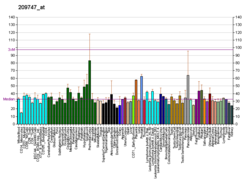Transforming growth factor beta-3 is a protein that in humans is encoded by the TGFB3 gene.[5][6]
It is a type of protein, known as a cytokine, which is involved in cell differentiation, embryogenesis and development. It belongs to a large family of cytokines called the Transforming growth factor beta superfamily, which includes the TGF-β family, Bone morphogenetic proteins (BMPs), growth and differentiation factors (GDFs), inhibins and activins.[7]
TGF-β3 is believed to regulate molecules involved in cellular adhesion and extracellular matrix (ECM) formation during the process of palate development. Without TGF-β3, mammals develop a deformity known as a cleft palate.[8][9] This is caused by failure of epithelial cells in both sides of the developing palate to fuse. TGF-β3 also plays an essential role in controlling the development of lungs in mammals, by also regulating cell adhesion and ECM formation in this tissue,[10] and controls wound healing by regulating the movements of epidermal and dermal cells in injured skin.[5]
- ^ a b c GRCh38: Ensembl release 89: ENSG00000119699 – Ensembl, May 2017
- ^ a b c GRCm38: Ensembl release 89: ENSMUSG00000021253 – Ensembl, May 2017
- ^ "Human PubMed Reference:". National Center for Biotechnology Information, U.S. National Library of Medicine.
- ^ "Mouse PubMed Reference:". National Center for Biotechnology Information, U.S. National Library of Medicine.
- ^ a b Bandyopadhyay B, Fan J, Guan S, Li Y, Chen M, Woodley DT, Li W (Mar 2006). "A "traffic control" role for TGFbeta3: orchestrating dermal and epidermal cell motility during wound healing". The Journal of Cell Biology. 172 (7): 1093–105. doi:10.1083/jcb.200507111. PMC 2063766. PMID 16549496.
- ^ "Entrez Gene: TGFB3 transforming growth factor, beta 3".
- ^ Herpin A, Lelong C, Favrel P (May 2004). "Transforming growth factor-beta-related proteins: an ancestral and widespread superfamily of cytokines in metazoans". Developmental and Comparative Immunology. 28 (5): 461–85. doi:10.1016/j.dci.2003.09.007. PMID 15062644.
- ^ Taya Y, O'Kane S, Ferguson MW (Sep 1999). "Pathogenesis of cleft palate in TGF-beta3 knockout mice". Development. 126 (17): 3869–79. doi:10.1242/dev.126.17.3869. PMID 10433915.
- ^ Dudas M, Nagy A, Laping NJ, Moustakas A, Kaartinen V (Feb 2004). "Tgf-beta3-induced palatal fusion is mediated by Alk-5/Smad pathway". Developmental Biology. 266 (1): 96–108. doi:10.1016/j.ydbio.2003.10.007. PMID 14729481.
- ^ Kaartinen V, Voncken JW, Shuler C, Warburton D, Bu D, Heisterkamp N, Groffen J (Dec 1995). "Abnormal lung development and cleft palate in mice lacking TGF-beta 3 indicates defects of epithelial-mesenchymal interaction". Nature Genetics. 11 (4): 415–21. doi:10.1038/ng1295-415. PMID 7493022. S2CID 22365206.





